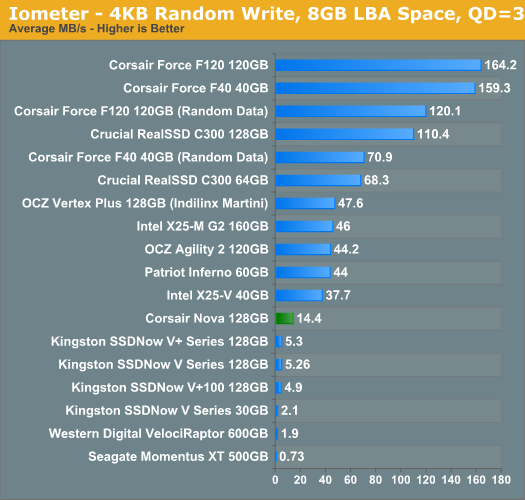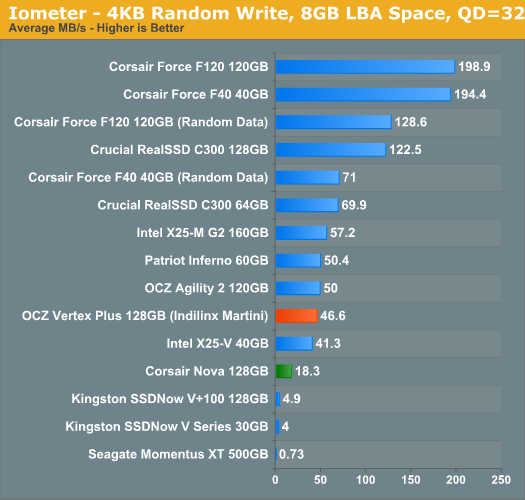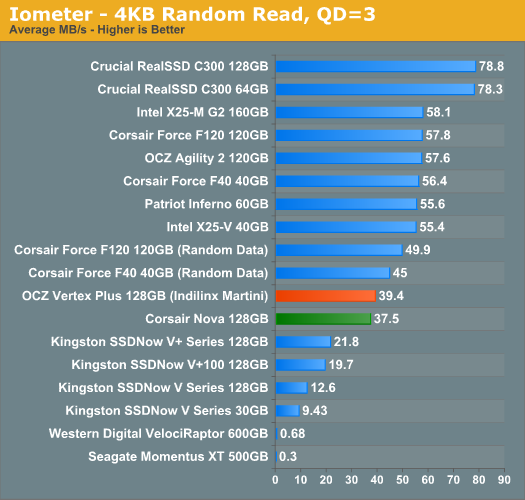OCZ Vertex Plus Preview: Introducing the Indilinx Martini
by Anand Lal Shimpi on November 16, 2010 9:31 AM EST- Posted in
- Storage
- SSDs
- OCZ
- Indilinx Martini
- Intrepid
Random Read/Write Speed
The four corners of SSD performance are as follows: random read, random write, sequential read and sequential write speed. Random accesses are generally small in size, while sequential accesses tend to be larger and thus we have the four Iometer tests we use in all of our reviews.
Our first test writes 4KB in a completely random pattern over an 8GB space of the drive to simulate the sort of random access that you'd see on an OS drive (even this is more stressful than a normal desktop user would see). As I've explained in the comments in previous reviews, simulating the type of random access you see in a desktop workload is difficult to do. Small file desktop accesses aren't usually sequential but they're not fully random either. By limiting the LBA space to 8GB we somewhat simulate a constrained random access pattern, but again it's still more random than what you'd see on your machine. Your best bet for real world performance is to look at our Storage Bench charts near the end of the review as they accurately record and play back traces of real world workloads.
For our random access tests I perform three concurrent IOs and run the test for 3 minutes. The results reported are in average MB/s over the entire time. We use both standard pseudo randomly generated data (data is random within a write, but duplicated between writes) for each write as well as fully random data (data is random within a write and random across most writes) to show you both the maximum and minimum performance offered by SandForce based drives in these tests. The average performance of SF drives will likely be somewhere in between the two values for each drive you see in the graphs. For an understanding of why the type of data you write to SF drives matters, read our original SandForce article.

The Corsair Nova is our Indilinx Barefoot representative in this preview and you can see how performance has improved with the Martini controller. While the original Indilinx Barefoot traded good sequential performance for slower-than-Intel random performance, Martini fixes the problem. It's not in the class of SandForce's SF-1200, but Indilinx appears to have built a performance equal to Intel's X25-M G2.
Many of you have asked for random write performance at higher queue depths. What I have below is our 4KB random write test performed at a queue depth of 32 instead of 3. While the vast majority of desktop usage models experience queue depths of 0 - 5, higher depths are possible in heavy I/O (and multi-user) workloads:

Our random read test is similar to the random write test however we lift the 8GB LBA space restriction:

Random read performance falls short of Intel and basically hasn't changed since the Barefoot. It's not bad at all, but not industry leading.










61 Comments
View All Comments
MeanBruce - Tuesday, November 16, 2010 - link
With SandForce recently releasing their SF-2000 controller stats Intel has delayed the G3s my guess is to rework the entire M and X lineup. I love my little X25-M, but with SF claiming read/writes approaching 500mg/s Intel just has to do something to stay competative! You know SandForce is just a little company in California with 83 employees, and some 80M in cash, when they go public buy buy buy!surt - Tuesday, November 16, 2010 - link
Sorry, but they are a HUGE ipo risk. They have one, first-generation product. It happens to perform better than the first generation products of huge, well known competitors. All competitors in this product space will be maxing out the interface bandwidth within 2 years. When that happens, do you think IT purchasers are going to choose sandforce over intel controllers? When that happens, their stock will tank on down to zero, and they will be a niche player if they are not out of business.Shadowmaster625 - Tuesday, November 16, 2010 - link
They will be bought by a Fortune500 company.MeanBruce - Wednesday, November 17, 2010 - link
I get where you're coming from, but SandForce is moving into using their controllers on PCIe cards with their newest client, guess who? Seagate! Yup knocked me off my chair when I heard the news too, but I think it's fantastic, no bandwidth problems there. Their first SKUs will be for enterprise. Thanks to SandForce the next offerings from Intel should be damn nice; things are getting interesting.MeanBruce - Tuesday, November 16, 2010 - link
Indilinx, I think I'll keep my shoes on!!!jaydee - Tuesday, November 16, 2010 - link
One of my big problems with all these SSD reviews, is they are almost always 120GB+ versions, when the mainstream market is 60-90GB and we have no idea how these SSD's scale down to smaller capacities.For instance, I WAS really impressed with the Crucial C300, come to find out just now that the 64GB version isn't in the same league as the 128GB. Others seem to take smaller performance hits as you move down in capacity (Intel X25-M 160GB vs 80GB). SandForce-1200? Who knows, there's no 60GB-90GB version in the storage bench, and I never see one in any of these benchmarks. Not everyone can afford a $200-300 SSD.
melgross - Tuesday, November 16, 2010 - link
That's very true, but the market is going to larger sizes. The only reason they have those small drives is because of cost. A year ago, 64GB drives cost as much as 128GB drives do now, and people were buying them. most of us have no interest in a drive smaller than 128GB, and even that's too small for anything other than a notebook. In order to replace my boot drive in my Mac Pro, I need a 256, and those are still too expensive.it's interesting that notebooks get criticized for having 256GB HDD's, but those same people think that a cheap 64GB SSD is fine.
jaydee - Tuesday, November 16, 2010 - link
Speak for yourself, I'm in the General Hardware forum everyday and there are way more questions about builds that have the budget for 60-80GB SSD's than 120GB+ (desktops obviously). The notebook market even futher proves this point, because 120GB still isn't enough for almost all laptop users.
I agree that the market is trending towards larger capacities at lower prices, but the fact is, there's a huge market for people who only need 60-80GB of boot storage, independant of pricing. If 60GB's cost $120 now, and $80 later and 120GB cost $230 now, $150 later, I have the great suspicion that most people are still going to go with the 60-80GB, and put the extra money saved, towards a better CPU or GPU. Because even with a 120GB SSD, 99% of people out there are still going to want a storage drive and SSD's aren't going to increase your frames per second, encoding times, etc.
I want to see a 60-80GB SSD roundup of different controllers! Indillinx, JMicron, Toshiba, Sandforce, Intel!
melgross - Tuesday, November 16, 2010 - link
As usual, it's not likely the forums reflect the majority of users. I would imagine that some people use those small drives because they don't have a choice because of the price, but would rather have a larger model.I really wonder if managing the content on these small drives is worth the few seconds cut off from any work session. I can see one for a scratch drive for PS though.
jaydee - Tuesday, November 16, 2010 - link
At newegg the top 3 and 8 of the top 10 "most reviewed" SSD's are 64GB or smaller. They don't directly show sales numbers.TigerDirect, SSD "Tigers Top Sellers" has 6 drives <=80GB, 3 that are >=120GB and one hybrid.
Superbiiz, sort the 2.5" SSD's 10 of the top 13 "best selling" are <80GB.
What evidence do you have that supports your claim of most users having 120GB SSD's or larger?